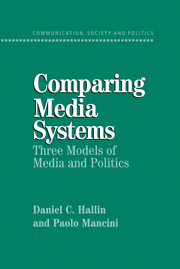8 - The Forces and Limits of Homogenization
Published online by Cambridge University Press: 05 September 2012
Summary
The preceding chapters have described three distinct media system models, and many variations among individual countries. It is clear, however, that the differences among these models, and in general the degree of variation among nation states, has diminished substantially over time. In 1970 the differences among the three groups of countries characterized by our three models were quite dramatic; a generation later, by the beginning of the twenty-first century, the differences have eroded to the point that it is reasonable to ask whether a single, global media model is displacing the national variation of the past, at least among the advanced capitalist democracies discussed in this book. Increasingly, as McQuail (1994) put it, an “international media culture” has become common to all the countries we studied. In this chapter we will focus on this process of convergence or homogenization, first summarizing the changes in European media systems that tend in this direction, then moving on to the questions of how the change can be explained, its limits and countertrends, and its implications for media theory, particularly focusing on the debate about “differentiation” raised in Chapter 4.
THE TRIUMPH OF THE LIBERAL MODEL
The Liberal Model has clearly become increasingly dominant across Europe as well as North America – as it has, no doubt, across much of the world – its structures, practices, and values displacing, to a substantial degree, those of the other media systems we have explored in the previous chapters.
- Type
- Chapter
- Information
- Comparing Media SystemsThree Models of Media and Politics, pp. 251 - 295Publisher: Cambridge University PressPrint publication year: 2004



